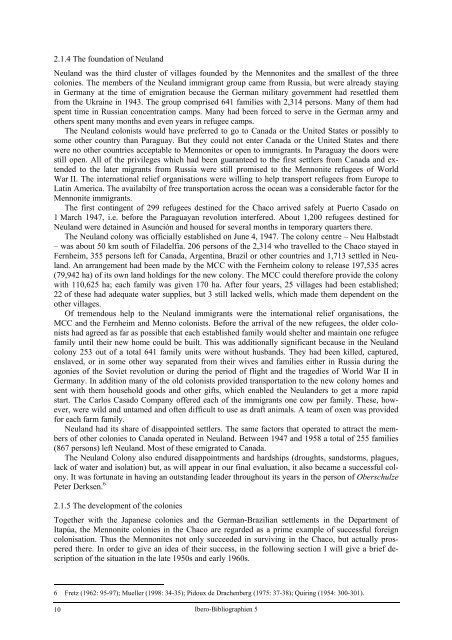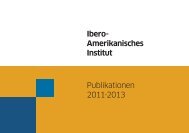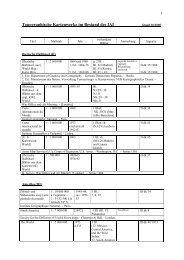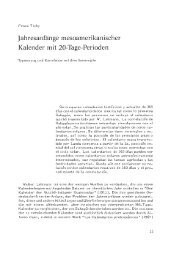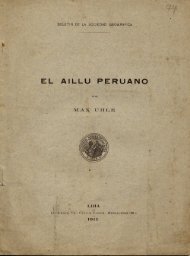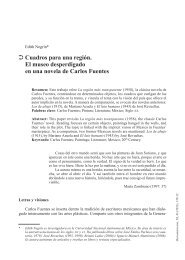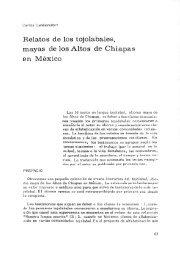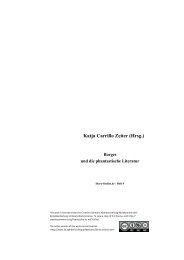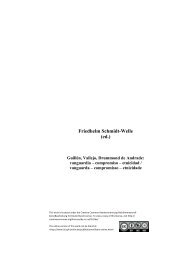The Mennonite Colonies in Paraguay. Origin - Ibero-Amerikanisches ...
The Mennonite Colonies in Paraguay. Origin - Ibero-Amerikanisches ...
The Mennonite Colonies in Paraguay. Origin - Ibero-Amerikanisches ...
You also want an ePaper? Increase the reach of your titles
YUMPU automatically turns print PDFs into web optimized ePapers that Google loves.
2.1.4 <strong>The</strong> foundation of Neuland<br />
Neuland was the third cluster of villages founded by the <strong>Mennonite</strong>s and the smallest of the three<br />
colonies. <strong>The</strong> members of the Neuland immigrant group came from Russia, but were already stay<strong>in</strong>g<br />
<strong>in</strong> Germany at the time of emigration because the German military government had resettled them<br />
from the Ukra<strong>in</strong>e <strong>in</strong> 1943. <strong>The</strong> group comprised 641 families with 2,314 persons. Many of them had<br />
spent time <strong>in</strong> Russian concentration camps. Many had been forced to serve <strong>in</strong> the German army and<br />
others spent many months and even years <strong>in</strong> refugee camps.<br />
<strong>The</strong> Neuland colonists would have preferred to go to Canada or the United States or possibly to<br />
some other country than <strong>Paraguay</strong>. But they could not enter Canada or the United States and there<br />
were no other countries acceptable to <strong>Mennonite</strong>s or open to immigrants. In <strong>Paraguay</strong> the doors were<br />
still open. All of the privileges which had been guaranteed to the first settlers from Canada and extended<br />
to the later migrants from Russia were still promised to the <strong>Mennonite</strong> refugees of World<br />
War II. <strong>The</strong> <strong>in</strong>ternational relief organisations were will<strong>in</strong>g to help transport refugees from Europe to<br />
Lat<strong>in</strong> America. <strong>The</strong> availabilty of free transportation across the ocean was a considerable factor for the<br />
<strong>Mennonite</strong> immigrants.<br />
<strong>The</strong> first cont<strong>in</strong>gent of 299 refugees dest<strong>in</strong>ed for the Chaco arrived safely at Puerto Casado on<br />
1 March 1947, i.e. before the <strong>Paraguay</strong>an revolution <strong>in</strong>terfered. About 1,200 refugees dest<strong>in</strong>ed for<br />
Neuland were deta<strong>in</strong>ed <strong>in</strong> Asunción and housed for several months <strong>in</strong> temporary quarters there.<br />
<strong>The</strong> Neuland colony was officially established on June 4, 1947. <strong>The</strong> colony centre – Neu Halbstadt<br />
– was about 50 km south of Filadelfia. 206 persons of the 2,314 who travelled to the Chaco stayed <strong>in</strong><br />
Fernheim, 355 persons left for Canada, Argent<strong>in</strong>a, Brazil or other countries and 1,713 settled <strong>in</strong> Neuland.<br />
An arrangement had been made by the MCC with the Fernheim colony to release 197,535 acres<br />
(79,942 ha) of its own land hold<strong>in</strong>gs for the new colony. <strong>The</strong> MCC could therefore provide the colony<br />
with 110,625 ha; each family was given 170 ha. After four years, 25 villages had been established;<br />
22 of these had adequate water supplies, but 3 still lacked wells, which made them dependent on the<br />
other villages.<br />
Of tremendous help to the Neuland immigrants were the <strong>in</strong>ternational relief organisations, the<br />
MCC and the Fernheim and Menno colonists. Before the arrival of the new refugees, the older colonists<br />
had agreed as far as possible that each established family would shelter and ma<strong>in</strong>ta<strong>in</strong> one refugee<br />
family until their new home could be built. This was additionally significant because <strong>in</strong> the Neuland<br />
colony 253 out of a total 641 family units were without husbands. <strong>The</strong>y had been killed, captured,<br />
enslaved, or <strong>in</strong> some other way separated from their wives and families either <strong>in</strong> Russia dur<strong>in</strong>g the<br />
agonies of the Soviet revolution or dur<strong>in</strong>g the period of flight and the tragedies of World War II <strong>in</strong><br />
Germany. In addition many of the old colonists provided transportation to the new colony homes and<br />
sent with them household goods and other gifts, which enabled the Neulanders to get a more rapid<br />
start. <strong>The</strong> Carlos Casado Company offered each of the immigrants one cow per family. <strong>The</strong>se, however,<br />
were wild and untamed and often difficult to use as draft animals. A team of oxen was provided<br />
for each farm family.<br />
Neuland had its share of disappo<strong>in</strong>ted settlers. <strong>The</strong> same factors that operated to attract the members<br />
of other colonies to Canada operated <strong>in</strong> Neuland. Between 1947 and 1958 a total of 255 families<br />
(867 persons) left Neuland. Most of these emigrated to Canada.<br />
<strong>The</strong> Neuland Colony also endured disappo<strong>in</strong>tments and hardships (droughts, sandstorms, plagues,<br />
lack of water and isolation) but, as will appear <strong>in</strong> our f<strong>in</strong>al evaluation, it also became a successful colony.<br />
It was fortunate <strong>in</strong> hav<strong>in</strong>g an outstand<strong>in</strong>g leader throughout its years <strong>in</strong> the person of Oberschulze<br />
Peter Derksen. 6<br />
2.1.5 <strong>The</strong> development of the colonies<br />
Together with the Japanese colonies and the German-Brazilian settlements <strong>in</strong> the Department of<br />
Itapúa, the <strong>Mennonite</strong> colonies <strong>in</strong> the Chaco are regarded as a prime example of successful foreign<br />
colonisation. Thus the <strong>Mennonite</strong>s not only succeeded <strong>in</strong> surviv<strong>in</strong>g <strong>in</strong> the Chaco, but actually prospered<br />
there. In order to give an idea of their success, <strong>in</strong> the follow<strong>in</strong>g section I will give a brief description<br />
of the situation <strong>in</strong> the late 1950s and early 1960s.<br />
6 Fretz (1962: 95-97); Mueller (1998: 34-35); Pidoux de Drachenberg (1975: 37-38); Quir<strong>in</strong>g (1954: 300-301).<br />
10<br />
<strong>Ibero</strong>-Bibliographien 5


